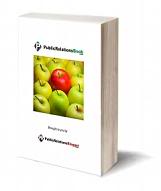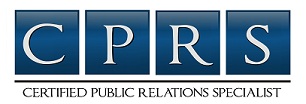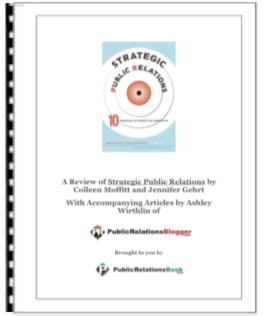________________________________________________________________________
Publicity is an important and often overlooked tool of creative selling; and a more cost-effective way of reaching your target audience than advertising. With the inherent third-party endorsement of the media implied in every editorial story, a news or feature article in a newspaper, magazine, or on television or radio, is an infinitely more credibly-perceived communications message than an ad or commercial. Publicists less frequently are favored with hard news stories. They are more often tasked with getting “softer” news and feature stories on-air or in print. Here are some techniques involving creative conceptualization and application - what I call CREATIVE FORMATTING - and they work very effectively when carefully thought-through and constructed.
1 - Use News to Make News.
When you prepare a press release or pitch letter, keep the following editorial criteria in mind:
* Relevance (how valid and appropriate is this story?)
* Impact (does this story affect a large number of people?)
* Timeliness (is the story current?)
* Novelty (does the story have an unusual or unique twist to it?)
Your topic should tie in with current news issues and/or subjects that concern the public. In my earlier p.r. days, I promoted one product by showing how it could be used to the advantage of a specific news item of the day. In this case, the issue was government waste. Revelations were surfacing that various federal agencies were buying products at absurd prices above retail: you may remember $500 toilet seats and $75 rulers. The American taxpayer was being seriously abused by bureaucratic waste.
Our client was a publishing house that had just come out with a directory for buyers at government agencies. The directory listed major manufacturers all over the country who were not in the business of ripping off Uncle Sam. The directory was distributed to the agencies free of charge. The publishing house made its money by selling ad pages to companies who wanted to attract the attention of these buying officials.
We attracted a significant amount of publicity by telling editors that the publishing company had come up with a partial solution to the problem of wasteful government spending. The story was picked up by the wire services and nationally syndicated TV newscasts.
2 - Seasonal Tie-ins
News editors are always looking for feature stories that tie in with holiday or seasonal happenings. I remember a very successful campaign for a manufacturer of postage meter equipment. Eight weeks before Christmas, we convinced the manufacturer to designate a Holiday Consumer Affairs Specialist who could talk about "everything you wanted to know about mailing gifts for the holidays."
Between Thanksgiving and Christmas, we arranged dozens of phone interviews with reporters at large radio stations in major markets. The company was plugged in every interview and the entire campaign tied-in with a major catalogue and in-store p.o.p. merchandising campaign. Sometimes, a creative p.r. idea can pave the way for a strategic marketing campaign.
Another successful campaign tied in with the advent of winter and escalating fuel prices due to an international oil crisis. One of our clients manufactured a draft sealer, a simple rubber plug that fit into electrical wall outlets. The sealer kept cold outside air from coming into the home and kept warm air inside from leaking out. Consumers could save money on their fuel bills. We convinced the Today Show to do a live five minute segment on a new energy-saving device for the home.
3 - Products Are Newsworthy When They Are Evolutionary or Revolutionary
On Sunday, May 29, 1994, we generated a story in the Business Section of the New York Times on a new kind of paper that changed color upon the touch of the hand. We knew the story had merit, because the product represents a revolutionary leap forward in paper goods.
Several years ago, a new product created by a camera manufacturer, an instant slide processor that develops slides in seconds, represented an evolutionary step up in instant photography. We offered Good Morning, America a first exclusive on the announcement, and we convinced the show's producers to have host Joan Lunden demonstrate the product live in a five minute segment. The product sold out nationally.
4 - Anniversaries
If the product is vital to the American way of life, the media might click with a suggestion for a story on a major anniversary of the product. This includes biggies like television, radio, refrigerators and cars all the way to such mundane indispensables as zippers and toothpaste.
Other kinds of anniversaries work too. During the centennial celebrations for the Statue of Liberty, we convinced Kelloggs to sponsor a campaign that publicized the closest living relative to the man who designed and built Lady Liberty. This included the scripting and shooting of a video news feature story for television newscasts around the country, and our pickup was enormous--including some very nice positive image reinforcement for Kelloggs.
5 - Controlled Messages
A controlled message is a message that you prepare in advance and place with various media as a finished product. When we promoted a book that turned into a major bestseller called Swim With the Sharks Without Being Eaten Alive by Harvey Mackay, we employed a number of techniques that come under this category.
Three examples of this technique are the video news feature, matted columns for suburban newspapers, and by-lined articles for specialized trade publications.
A video news feature is simply a 90-second to two-minute news piece that gets scripted, shot and distributed to newscasts around the country. The local newscast incorporates the piece as part of its news coverage, and the average viewer has no idea these stories are supplied by outside sources.
A matted column is simply a one-column or two-column story that is sent to suburban news weeklies as camera-ready copy. They don't have to edit it or prepare it for print. The column usually offers some kind of consumer advice, with a discreet yet effective plug within the story.
Vertical trade publications are magazines that are published for a specific audience or industry. Hundreds of them are published each month. Years ago, we ghosted by-lined articles for the president of a company that analyzed utility rates for other companies, showing them how to save thousands of dollars every year. These articles were placed with dozens of magazines that catered to a variety of industries. This campaign was the company's sole marketing vehicle for many years.
6 - Trends
When one of our clients, a major photography magazine, needed to increase its exposure, we designed a segment on The Today Show in which one of the magazine's editors brought the very latest camera equipment to the program. For seven minutes, he demonstrated the most current camera technology to millions of viewers. He also achieved some substantial awareness for his magazine.
Another client, the Magazine Publishers Association, was interested in increasing recognition. They wanted to establish the fact that magazines are at the leading edge of creative advertising communication. We designed a segment on The Today Show that displayed the latest in pop-up ads in various magazines.
In another situation, a German beer company wanted to increase sales in the USA. The company turned to us, asking us to increase their name recognition with a publicity program instead of advertising. The built-in challenge was that very little can be done editorially for alcoholic beverages. The solution was to look for secondary uses which would nonetheless position the beer in a meaningful and positive way.
We convinced a well-known German restaurant to develop dishes prepared with beer as an ingredient. We invited the entire national food press to a Cooking With Beer Festival. The food writers for every major magazine and newspaper attended. Media coverage was staggering. Many products can be used in special publicity events. By promoting indirectly, sponsors can reap media coverage.
POSITIVE PUBLICITY SELLS. A creative publicity program can be a powerful tool for selling your product or service. Publicity efforts can be more cost-effective than traditional advertising. Plus, they pack more power because the publicity comes from recognized media sources instead of from your company. This increases consumer confidence and promotes a positive public image. The end result of creative publicity is an increased awareness that attracts potential customers.
Mike Schwager is President of Worldlink Media Consultants, Inc., based in Ft. Lauderdale, Florida. He is an accomplished veteran of media interview training, and has conducted successful trainings for scores of CEO’s and other senior executives, politicians, celebrities and authors.
Article Source.
Tags: publicity, marketing tools, public relations, PR
A Guide to Using Publicity and Public Relations as Marketing Tools
________________________________________
Publicity is an important and often overlooked tool of creative selling; and a more cost-effective way of reaching your target audience than advertising. With the inherent third-party endorsement of the media implied in every editorial story, a news or feature article in a newspaper, magazine, or on television or radio, is an infinitely more credibly-perceived communications message than an ad or commercial. Publicists less frequently are favored with hard news stories. They are more often tasked with getting “softer” news and feature stories on-air or in print. Here are some techniques involving creative conceptualization and application - what I call CREATIVE FORMATTING - and they work very effectively when carefully thought-through and constructed.1 - Use News to Make News.
When you prepare a press release or pitch letter, keep the following editorial criteria in mind:
* Relevance (how valid and appropriate is this story?)
* Impact (does this story affect a large number of people?)
* Timeliness (is the story current?)
* Novelty (does the story have an unusual or unique twist to it?)
Your topic should tie in with current news issues and/or subjects that concern the public. In my earlier p.r. days, I promoted one product by showing how it could be used to the advantage of a specific news item of the day. In this case, the issue was government waste. Revelations were surfacing that various federal agencies were buying products at absurd prices above retail: you may remember $500 toilet seats and $75 rulers. The American taxpayer was being seriously abused by bureaucratic waste.
Our client was a publishing house that had just come out with a directory for buyers at government agencies. The directory listed major manufacturers all over the country who were not in the business of ripping off Uncle Sam. The directory was distributed to the agencies free of charge. The publishing house made its money by selling ad pages to companies who wanted to attract the attention of these buying officials.
We attracted a significant amount of publicity by telling editors that the publishing company had come up with a partial solution to the problem of wasteful government spending. The story was picked up by the wire services and nationally syndicated TV newscasts.
2 - Seasonal Tie-ins
News editors are always looking for feature stories that tie in with holiday or seasonal happenings. I remember a very successful campaign for a manufacturer of postage meter equipment. Eight weeks before Christmas, we convinced the manufacturer to designate a Holiday Consumer Affairs Specialist who could talk about "everything you wanted to know about mailing gifts for the holidays."
Between Thanksgiving and Christmas, we arranged dozens of phone interviews with reporters at large radio stations in major markets. The company was plugged in every interview and the entire campaign tied-in with a major catalogue and in-store p.o.p. merchandising campaign. Sometimes, a creative p.r. idea can pave the way for a strategic marketing campaign.
Another successful campaign tied in with the advent of winter and escalating fuel prices due to an international oil crisis. One of our clients manufactured a draft sealer, a simple rubber plug that fit into electrical wall outlets. The sealer kept cold outside air from coming into the home and kept warm air inside from leaking out. Consumers could save money on their fuel bills. We convinced the Today Show to do a live five minute segment on a new energy-saving device for the home.
3 - Products Are Newsworthy When They Are Evolutionary or Revolutionary
On Sunday, May 29, 1994, we generated a story in the Business Section of the New York Times on a new kind of paper that changed color upon the touch of the hand. We knew the story had merit, because the product represents a revolutionary leap forward in paper goods.
Several years ago, a new product created by a camera manufacturer, an instant slide processor that develops slides in seconds, represented an evolutionary step up in instant photography. We offered Good Morning, America a first exclusive on the announcement, and we convinced the show's producers to have host Joan Lunden demonstrate the product live in a five minute segment. The product sold out nationally.
4 - Anniversaries
If the product is vital to the American way of life, the media might click with a suggestion for a story on a major anniversary of the product. This includes biggies like television, radio, refrigerators and cars all the way to such mundane indispensables as zippers and toothpaste.
Other kinds of anniversaries work too. During the centennial celebrations for the Statue of Liberty, we convinced Kelloggs to sponsor a campaign that publicized the closest living relative to the man who designed and built Lady Liberty. This included the scripting and shooting of a video news feature story for television newscasts around the country, and our pickup was enormous--including some very nice positive image reinforcement for Kelloggs.
5 - Controlled Messages
A controlled message is a message that you prepare in advance and place with various media as a finished product. When we promoted a book that turned into a major bestseller called Swim With the Sharks Without Being Eaten Alive by Harvey Mackay, we employed a number of techniques that come under this category.
Three examples of this technique are the video news feature, matted columns for suburban newspapers, and by-lined articles for specialized trade publications.
A video news feature is simply a 90-second to two-minute news piece that gets scripted, shot and distributed to newscasts around the country. The local newscast incorporates the piece as part of its news coverage, and the average viewer has no idea these stories are supplied by outside sources.
A matted column is simply a one-column or two-column story that is sent to suburban news weeklies as camera-ready copy. They don't have to edit it or prepare it for print. The column usually offers some kind of consumer advice, with a discreet yet effective plug within the story.
Vertical trade publications are magazines that are published for a specific audience or industry. Hundreds of them are published each month. Years ago, we ghosted by-lined articles for the president of a company that analyzed utility rates for other companies, showing them how to save thousands of dollars every year. These articles were placed with dozens of magazines that catered to a variety of industries. This campaign was the company's sole marketing vehicle for many years.
6 - Trends
When one of our clients, a major photography magazine, needed to increase its exposure, we designed a segment on The Today Show in which one of the magazine's editors brought the very latest camera equipment to the program. For seven minutes, he demonstrated the most current camera technology to millions of viewers. He also achieved some substantial awareness for his magazine.
Another client, the Magazine Publishers Association, was interested in increasing recognition. They wanted to establish the fact that magazines are at the leading edge of creative advertising communication. We designed a segment on The Today Show that displayed the latest in pop-up ads in various magazines.
In another situation, a German beer company wanted to increase sales in the USA. The company turned to us, asking us to increase their name recognition with a publicity program instead of advertising. The built-in challenge was that very little can be done editorially for alcoholic beverages. The solution was to look for secondary uses which would nonetheless position the beer in a meaningful and positive way.
We convinced a well-known German restaurant to develop dishes prepared with beer as an ingredient. We invited the entire national food press to a Cooking With Beer Festival. The food writers for every major magazine and newspaper attended. Media coverage was staggering. Many products can be used in special publicity events. By promoting indirectly, sponsors can reap media coverage.
POSITIVE PUBLICITY SELLS. A creative publicity program can be a powerful tool for selling your product or service. Publicity efforts can be more cost-effective than traditional advertising. Plus, they pack more power because the publicity comes from recognized media sources instead of from your company. This increases consumer confidence and promotes a positive public image. The end result of creative publicity is an increased awareness that attracts potential customers.
Mike Schwager is President of Worldlink Media Consultants, Inc., based in Ft. Lauderdale, Florida. He is an accomplished veteran of media interview training, and has conducted successful trainings for scores of CEO’s and other senior executives, politicians, celebrities and authors.
Article Source.
Tags: publicity, marketing tools, public relations, PR
Popular choices
- Non Gamstop Casino
- Mejores Salas De Póker
- Non Gamstop Casinos
- Siti Casino Online Non Aams
- Migliori Siti Casino Online
- UK Online Casinos Not On Gamstop
- Non Gamstop Casino Sites UK
- Non Gamstop Casino Sites UK
- UK Casino Not On Gamstop
- Casinos Not On Gamstop
- Online Casino
- オンラインカジノ
- UK Casino Not On Gamstop
- UK Casino Not On Gamstop
- Reputable Non Gamstop Casinos
- Casinos Not On Gamstop
- Best Non Gamstop Casinos
- Non Gamstop Casino
- Casinos Not On Gamstop
- Slots Not On Gamstop
Subscribe to:
Post Comments (Atom)






Comments (0)
Post a Comment